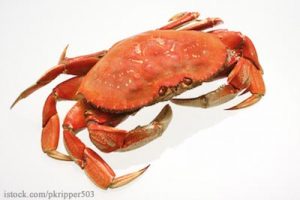The California Department of Public health advised consumers not to eat Dungeness and Rock crabs caught in waters between the Oregon border and the southern Santa Barbara county line because of dangerous levels of domoic acid. This naturally occurring toxin can cause food poisoning.
 Test results have shown “persistently high levels” of domoic acid in these shellfish. The levels are over the state’s action level for the crab’s body meat as well as the viscera, which is also known as crab butter. These crabs pose a “significant risk to the public” if they are eaten. Domoic acid is related to a bloom of a single-celled plant called Pseudo-nitzschia. Conditions that support the growth of this plant are not possible to predict, so food safety experts rely on continuous testing to check if these shellfish are safe to consume or not.
Test results have shown “persistently high levels” of domoic acid in these shellfish. The levels are over the state’s action level for the crab’s body meat as well as the viscera, which is also known as crab butter. These crabs pose a “significant risk to the public” if they are eaten. Domoic acid is related to a bloom of a single-celled plant called Pseudo-nitzschia. Conditions that support the growth of this plant are not possible to predict, so food safety experts rely on continuous testing to check if these shellfish are safe to consume or not.
Sampling will continue to monitor the toxin levels. When the levels go down and do not exceed the action level of 30 ppm in the viscera and 20 ppm in the, the advisory will be lifted.
The symptoms of domoic acid poisoning include vomiting, diarrhea, abdominal cramps, headache, and dizziness. The symptoms usually appear within 30 minutes to 24 hours after eating contaminated seafood.
Some people may become more seriously ill, and experience symptoms such as trouble breathing, confusion, disorientation, cardiovascular instability, seizures, permanent loss of short term memory (otherwise known as Amnesiac Shellfish Poisoning), and excessive bronchial secretions. Some people may become so ill they lapse into a coma and may die. There have not been any reported illnesses to date in connection with the consumption of these products.




